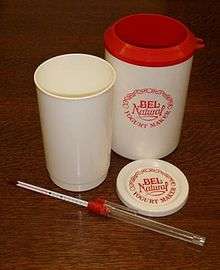Cookbook:Fermentation
Cookbook | Recipes | Ingredients | Cooking techniques
Fermentation is the process of controlling bacteria, yeast, and moulds to modify food, producing a desired product.
Fermentation can improve food so that it:
- Tastes different, bringing new, often strong flavours to the source foods
- Is easier to digest
- Is more nutritious
- Lasts longer
How to Ferment a Food
As with any food preparation, there are certain aspects of the fermentation process that can change the quality and acceptability of the end product. Here are some of the important ones that are generally applicable; check individual recipes for special tips and variations.
Ingredient selection
Selecting good quality ingredients is important when fermenting food. It doesn't generally matter if the ingredients aren't picture perfect – cider vinegar won't look or taste any different for using ugly apples – but avoid using old, rotting, or very dirty food. Remember that a fermentation is where yeast and bacteria are given a chance to multiply, so give your ferment a fighting chance and stick to good quality ingredients.
Salt
Many ferments use salt. Salt helps by inhibiting undesirable bacteria and moulds, and by drawing juices out of foods. It is best to use a salt that has no free-flow agents or iodine added to it, as these can inhibit the fermentation a little. Iodine is an effective antibacterial agent, and even in the very small amounts used in iodised salt, it can affect the bacteria that ferment the food. Salt suitable for fermenting is often called "pickling salt" or "Kosher salt".
Iodine is an effective antibacterial agent, but that is not what we are talking about here, in iodized table salt. The chemical additive is Sodium Iodide ie. Iodine in chemical combination with Sodium. Sodium Iodide is not antibacterial. The same thing applies to deadly Chlorine gas, but in combination with Sodium it equals Sodium Chloride, table salt.
Water
When adding water to a fermentation, avoid chlorinated water if possible. Chlorine is added to municipal water supplies to prevent the build-up of bacteria and other water-borne microorganisms, and as such can inhibit a fermentation.
Tap water can be made chlorine-free in most areas simply by boiling it and letting it cool again, or even just by leaving it in an uncovered pot overnight. This doesn't work in areas where the water is chlorinated by adding chloramine to the water, a practice done specifically to keep the chlorine in the water. Many modern water filters will remove both chlorine and chloramine, however.
Temperature

All fermentations are temperature sensitive. Some prefer it cooler, some hotter. Many are best served by warmer temperature at the start of fermentation, and cooler temperatures once fermenting has peaked. Temperature affects which microorganisms grow fastest, and can affect the flavour of the food, or even whether it will succeed or fail.
Here are some common ferments, and typical fermenting temperatures.
| Fermented food | Start temperature | Post-peak temperature |
|---|---|---|
| Lager | 9-13°C | diacetyl rest 18-22°C, lagering 0-1°C |
| Kefir | 18-22°C | |
| Sauerkraut | 18-22°C | 8-10°C |
| Tempeh | 30-35°C | 25°C |
| Yoghurt | 45°C |
As can be seen, it is useful to be able to control the temperature of a fermentation. Some common ways to control the temperature are:
- sit the fermenting food in a picnic cooler or esky
- sit the container of fermenting food in a basin or tub of water at the desired temperature (because water has greater thermal mass than air, and changes temperature more slowly)
- put the fermenting food into an electric oven, and use the oven light to keep it warm (because oven lights are usually incandescent bulbs, which produce more heat than light)
- make a specialised incubator for fermenting – e.g an old picnic cooler with a heat source and a thermostat, or a refrigerator with a variable thermostat and heat source
- buy a specialised incubator for fermenting – e.g. a yoghurt maker, or an oven with a 45°C yoghurt mode (as sold in Turkey!)
Fermented Foods
See also
- Category:Fermented food recipes
External links
- The Sauerkraut Fermentation
- Wild Fermentation: Making Sauerkraut
- Making Sauerkraut & Pickled Vegetables at Home